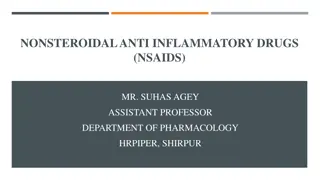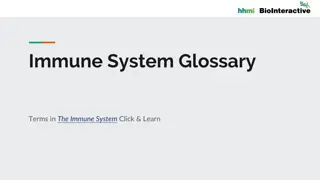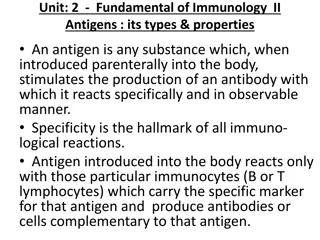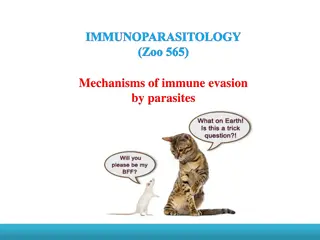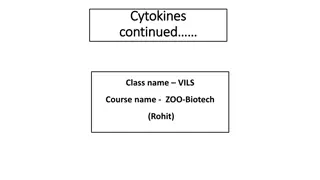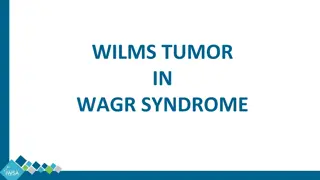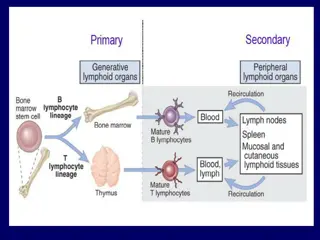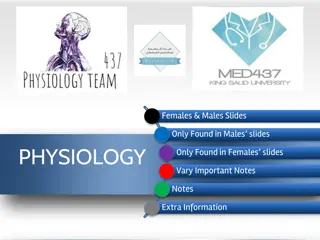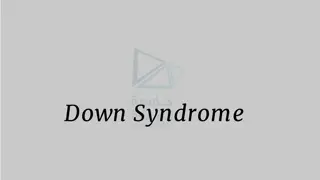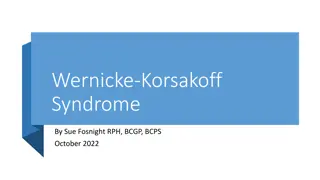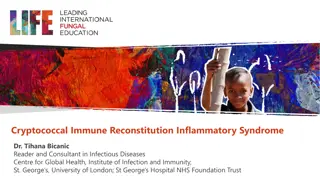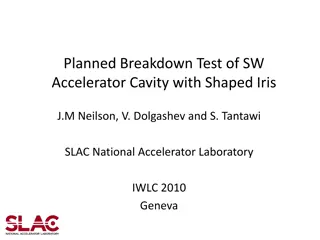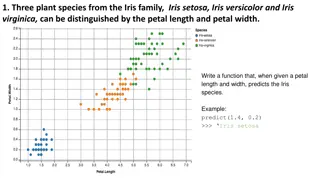Management of Immune Reconstitution Inflammatory Syndrome (IRIS) Guidelines
This guideline provides recommendations for managing Immune Reconstitution Inflammatory Syndrome (IRIS) in patients undergoing Antiretroviral Therapy (ART). It covers terminology, treatment recommendations, initiating ART, key points, and emphasizes not interrupting ART except in life-threatening cases. Healthcare providers are encouraged to seek assistance from experienced HIV care providers when managing IRIS to ensure optimal patient outcomes.
Download Presentation

Please find below an Image/Link to download the presentation.
The content on the website is provided AS IS for your information and personal use only. It may not be sold, licensed, or shared on other websites without obtaining consent from the author.If you encounter any issues during the download, it is possible that the publisher has removed the file from their server.
You are allowed to download the files provided on this website for personal or commercial use, subject to the condition that they are used lawfully. All files are the property of their respective owners.
The content on the website is provided AS IS for your information and personal use only. It may not be sold, licensed, or shared on other websites without obtaining consent from the author.
E N D
Presentation Transcript
Management of Immune Reconstitution Inflammatory Syndrome (IRIS) www.hivguidelines.org MARCH 2024 NYSDOH AIDS Institute Clinical Guidelines Program
Purpose of This Guideline Purpose of This Guideline Raise awareness among healthcare providers about IRIS, including its clinical presentation. Provide treatment recommendations for IRIS. Encourage clinicians to seek the assistance of an experienced HIV care provider when managing IRIS. Emphasize that ART should not be interrupted in patients with IRIS except in life-threatening cases. MARCH 2024 NYSDOH AIDS Institute Clinical Guidelines Program www.hivguidelines.org
Terminology Terminology IRIS: An undesirable disease- or pathogen-specific inflammatory response that may be triggered by ART-associated immune system recovery. Immune restoration disease: Another name for IRIS. Paradoxical IRIS: Refers to the worsening of a previously diagnosed disease after ART initiation. Unmasking IRIS: Refers to the appearance of a previously undiagnosed disease following ART initiation. MARCH 2024 NYSDOH AIDS Institute Clinical Guidelines Program www.hivguidelines.org
Recommendations: Recommendations: Initiating ART Initiating ART Clinicians should recommend that patients initiate ART within 2 weeks of beginning treatment for active OIs, with exceptions to this recommendation noted below. (A1) Clinicians should consult with a care provider experienced in managing HIV in patients with active OIs to determine when to initiate ART in patients with TB meningitis, extrapulmonary TB, CMV retinitis, or cryptococcal infection. (A3) For patients with CD4 counts <100 cells/mm3 or known concomitant OIs who are initiating ART, clinicians should be vigilant for the signs and symptoms of IRIS and should educate patients about the risk of developing IRIS. (A3) For patients with HIV who have HBV or HCV co-infection, clinicians should: Measure transaminase levels before initiation of ART, at 6 and 12 weeks after initiation, and at least every 6 months thereafter to monitor for possible IRIS. (A3) Refer patients with elevated transaminase levels in conjunction with jaundice, elevated bilirubin levels, or loss of synthetic function for evaluation by a hepatologist. (B3) MARCH 2024 NYSDOH AIDS Institute Clinical Guidelines Program www.hivguidelines.org
Key Points: Key Points: Initiating ART Initiating ART Clinicians should strongly recommend that patients being treated for infections other than TB meningitis, cryptococcal disease, and CMV retinitis initiate ART within 2 weeks of starting OI treatment or as soon as the patient is clinically stable on OI therapy and the potential for drug-drug interactions has been minimized. Before initiating ART in patients who have TB meningitis, extrapulmonary TB, CMV retinitis, or cryptococcal infection, clinicians should consult with a care provider who is experienced in managing the care of patients with HIV in patients with active OIs. The Clinical Education Initiative (CEI) Line, which is available through the New York State Department of Health CEI, provides access to care providers with experience in managing all aspects of HIV infection: 866- 637-2342. MARCH 2024 NYSDOH AIDS Institute Clinical Guidelines Program www.hivguidelines.org
Summary of Recommendations Regarding Summary of Recommendations Regarding Timing of ART Initiation Timing of ART Initiation Opportunistic Infection Cryptosporidiosis Microsporidiosis Progressive multifocal leukoencephalopathy Kaposi s sarcoma Pneumocystis jiroveci pneumonia (formerly PCP) Hepatitis B virus infection Hepatitis C virus infection Pulmonary TB Other serious bacterial infections Timing of ART Initiation After Starting OI Treatments Within 2 weeks of starting treatment for an OI or as soon as the patient is clinically stable. CD4 count >50 cells/mm3: Initiate ART as soon as the patient is clinically stable after initiating TB therapy, but no more than 12 weeks later. CD4 count <50 cells/mm3: Initiate ART within the first 2 weeks after initiating TB therapy. Pulmonary TB MARCH 2024 NYSDOH AIDS Institute Clinical Guidelines Program www.hivguidelines.org
Summary of Recommendations Regarding Summary of Recommendations Regarding Timing of ART Initiation, Timing of ART Initiation, continued continued Opportunistic Infection Timing of ART Initiation After Starting OI Treatments Extrapulmonary TB Optimal timing has not been established; consult with an experienced HIV care provider. TB meningitis Optimal timing has not been established; consult with an experienced HIV care provider. Delay 2 to 10 weeks after starting antifungal therapy. Optimal timing has not been established; consult with an experienced HIV care provider. Delay at least 2 weeks after starting antifungal therapy. Optimal timing has not been established; consult with an experienced HIV care provider. Immediate ART is not recommended. Optimal timing has not been established; consult with an experienced HIV care provider. Cryptococcal meningitis Cryptococcal infection other than meningitis Cytomegalovirus retinitis MARCH 2024 NYSDOH AIDS Institute Clinical Guidelines Program www.hivguidelines.org
Recommendations: Recommendations: Pulmonary TB Pulmonary TB For patients with pulmonary TB, clinicians should initiate ART as follows: CD4 counts 50 cells/mm3: As soon as patients are clinically stable on anti-TB therapy and no later than 12 weeks after initiating anti-TB therapy. (A1) CD4 counts <50 cells/mm3: Within the first 2 weeks after initiating anti- TB therapy. (A1) For patients with pulmonary TB who are ART-naive, who have a CD4 count <100 cells/mm3, and who started on anti-TB treatment within the last 30 days, clinicians should initiate prednisone 40 mg daily for 14 days, followed by 20 mg daily for 14 days at the time of ART initiation. (B1) MARCH 2024 NYSDOH AIDS Institute Clinical Guidelines Program www.hivguidelines.org
Recommendation: Recommendation: TB Meningitis or Extrapulmonary TB TB Meningitis or Extrapulmonary TB For patients with TB meningitis or extrapulmonary TB, clinicians should consult with an experienced HIV care provider to determine the timing of ART initiation. (A3) MARCH 2024 NYSDOH AIDS Institute Clinical Guidelines Program www.hivguidelines.org
Recommendations: Recommendations: Cryptococcal Meningitis Cryptococcal Meningitis Clinicians should treat ART-naive patients diagnosed with cryptococcal meningitis with standard antifungal therapy and should: Delay ART initiation until the patient has completed at least 2 weeks of antifungal treatment. (A1) Consult with an experienced HIV care provider to determine optimal timing for ART initiation. (A3) If the patient initiates ART before completing 10 weeks of antifungal therapy, the clinician should monitor closely for increased intracranial pressure and other signs and symptoms of IRIS and manage intracranial pressure aggressively. (A2) For patients with other types of cryptococcal infection (not meningitis), clinicians should consult with an experienced HIV care provider to determine the timing of ART initiation. (A3) MARCH 2024 NYSDOH AIDS Institute Clinical Guidelines Program www.hivguidelines.org
Key Points: Key Points: Cryptococcal Meningitis Cryptococcal Meningitis Steroids should not be used routinely as induction therapy in treatment of cryptococcal IRIS. Steroids are not effective in reducing intracranial pressure. MARCH 2024 NYSDOH AIDS Institute Clinical Guidelines Program www.hivguidelines.org
Recommendations: Recommendations: CMV Retinitis CMV Retinitis Clinicians should not initiate ART immediately in patients with known or strongly suspected CMV retinitis (A2) but should consult with an experienced HIV care provider to determine the timing of ART initiation. (A3) Clinicians should refer patients with HIV who have CD4 counts <100 cells/mm3 but without known or suspected CMV for a dilated ophthalmologic examination as soon as possible after initiating ART to assess for signs of CMV. (A2) If the dilated exam shows signs of CMV, clinicians should consult with an experienced HIV care provider. Clinicians should ensure that after initiating ART, patients with a history of CMV retinitis are monitored by dilated ophthalmologic examination to assess for possible IRIS as follows: Every 3 months for the first year after initiation of ART. (A3) Immediately if there is a change in visual acuity or development of floaters. (A2) MARCH 2024 NYSDOH AIDS Institute Clinical Guidelines Program www.hivguidelines.org
Recommendations: Recommendations: Diagnosing IRIS Diagnosing IRIS Clinicians should include IRIS as part of the differential diagnosis when inflammatory signs or symptoms occur following recent initiation of, re-initiation of, or a change to an ART regimen. (A3) In assessing patients for IRIS, clinicians should exclude HIV disease progression, new infections, and drug reactions as underlying causes for inflammatory signs or symptoms. (A3) MARCH 2024 NYSDOH AIDS Institute Clinical Guidelines Program www.hivguidelines.org
Major Presentations of IRIS Major Presentations of IRIS Underlying Opportunistic Infection IRIS Signs/Symptoms Patients responding to TB treatment may have worsening of pulmonary symptoms, X-ray findings that suggest worsening of TB disease, enlarging lymph nodes causing airway obstruction, or meningeal symptoms. Enlarging tuberculoma or pericardial effusions have been described. TB-IRIS can also result in acute hepatitis, which may be difficult to distinguish from medication-induced toxicity. Undiagnosed multidrug-resistant TB can mimic TB-IRIS and should be ruled out in patients whose symptoms worsen while receiving first-line TB treatment. May present as pulmonary disease or systemic inflammation that is indistinguishable from active MAC. Atypical presentations, such as localized lymphadenitis or endobronchial mass lesions, may occur; osteomyelitis is an atypical late manifestation. Patients with MAC-IRIS may not be bacteremic and may have no known history of a MAC diagnosis. Tuberculosis (TB) Mycobacterium avium complex (MAC) Cryptococcal meningitis Usually presents as worsening of meningitis symptoms, including possible rapid hearing and/or vision loss, ataxia, and/or elevated intracranial pressure. MARCH 2024 NYSDOH AIDS Institute Clinical Guidelines Program www.hivguidelines.org
Major Presentations of IRIS, Major Presentations of IRIS, continued continued Underlying Opportunistic Infection IRIS Signs/Symptoms Presents as retinitis, vitritis, or uveitis (variable timing, with median time to immune reconstitution vitritis 20 weeks after ART initiation in one study): Retinitis is inflammation that is usually at the site of previous CMV retinitis lesions. Uveitis and vitritis are the presence of inflammatory cells in the eye as a result of IRIS and may help to distinguish IRIS from active CMV retinitis. CMV-IRIS in the eye can cause rapid and permanent vision loss. Transient elevations in transaminases may occur after initiation of ART with immune reconstitution and can be difficult to distinguish from drug-induced hepatitis. Hepatic flares are usually mild and self-limited but can result in decompensation in someone with pre-existing cirrhosis. Cytomegalovirus (CMV) retinitis Hepatitis B or C virus Progressive multifocal leukoencephalopathy (PML) PML lesions may be unmasked or worsen and could appear as new or worsening focal neurologic deficits or lesions on MRI. MARCH 2024 NYSDOH AIDS Institute Clinical Guidelines Program www.hivguidelines.org
Major Presentations of IRIS, Major Presentations of IRIS, continued continued Underlying Opportunistic Infection IRIS Signs/Symptoms Presents as worsening of KS. Cutaneous lesions are the most common presentation; other signs include lymphedema and oral, gastric, lung, genital, or conjunctival lesions. Fatal cases of KS-IRIS have been reported. Kaposi s sarcoma (KS) Cerebral toxoplasmosis May present as a cerebral abscess (also known as toxoplasmosis encephalitis) or, rarely, diffuse encephalitis or chorioretinitis. Histoplasmosis May present as mucocutaneous lesions, disseminated disease, or fever without localizing symptoms. Pre-existing sarcoidosis may be exacerbated. Late presentations of Grave s disease have been reported 8 to 33 months after ART initiation. Autoimmune diseases MARCH 2024 NYSDOH AIDS Institute Clinical Guidelines Program www.hivguidelines.org
Minor Presentations of IRIS Minor Presentations of IRIS Underlying Opportunistic Infection IRIS Signs/Symptoms HSV and VZV can reactivate after initiation of ART, even in patients without previously diagnosed disease. Presentations are usually similar to non-IRIS disease; however, IRIS may worsen a patient s symptoms. Herpes simplex virus (HSV) and varicella zoster virus (VZV) Mpox Several case reports have described worsening of previously crusted lesions, the appearance of new lesions, and necrosis after ART initiation. Nonspecific dermatologic complications A number of dermatologic manifestations, such as folliculitis and oral and genital warts, may appear or worsen during immune reconstitution. MARCH 2024 NYSDOH AIDS Institute Clinical Guidelines Program www.hivguidelines.org
Recommendations: Recommendations: Management and Treatment of IRIS Management and Treatment of IRIS Clinicians should initiate appropriate treatment of OIs, as well as symptomatic treatment and supportive care according to the severity of IRIS. (A3) Clinicians should not interrupt antiretroviral therapy (ART) except in severe, life-threatening cases of IRIS. (A3) Clinicians should not use prednisone to prevent IRIS in patients with low CD4 counts who do not have active TB. (A3) MARCH 2024 NYSDOH AIDS Institute Clinical Guidelines Program www.hivguidelines.org
Recommendations: Recommendations: Severe IRIS Severe IRIS Clinicians should consult with an experienced HIV care provider for the management of severe IRIS, including the decision of whether to interrupt ART if IRIS is severe. (A3) Clinicians should treat patients with severe IRIS that is not caused by either cryptococcal meningitis or KS with 1 to 2 mg/kg prednisone, or the equivalent, for 1 to 2 weeks, followed by a period of tapering dose that is individualized. (B3) Clinicians should not use corticosteroids for management of cryptococcal meningitis or in patients with KS. (A2) Clinicians should closely monitor patients receiving corticosteroids for the development of OIs, including CMV retinitis and TB disease. (A3) MARCH 2024 NYSDOH AIDS Institute Clinical Guidelines Program www.hivguidelines.org
Key Point Key Point: : Severe Severe IRIS IRIS ART should not be interrupted in patients with IRIS except in life- threatening cases, usually associated with CNS-IRIS, in which corticosteroids did not result in improvement. MARCH 2024 NYSDOH AIDS Institute Clinical Guidelines Program www.hivguidelines.org
Need Help? Need Help? NYSDOH AIDS Institute Clinical Guidelines Program www.hivguidelines.org
Access the Guideline Access the Guideline www.hivguidelines.org > Management of IRIS Also available: Printable pocket guide and PDF NYSDOH AIDS Institute Clinical Guidelines Program www.hivguidelines.org


